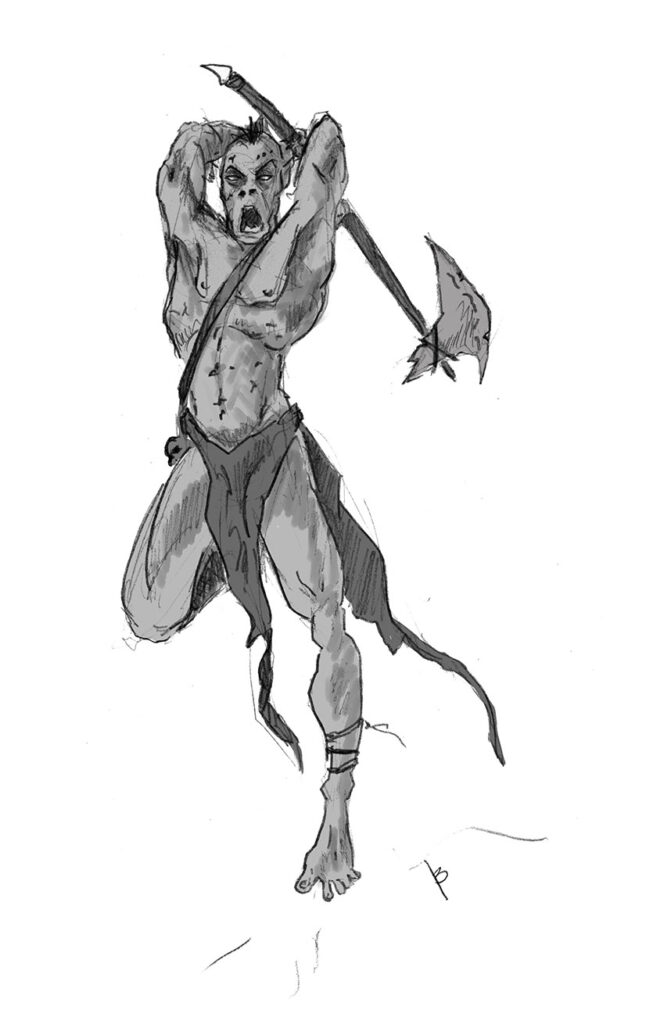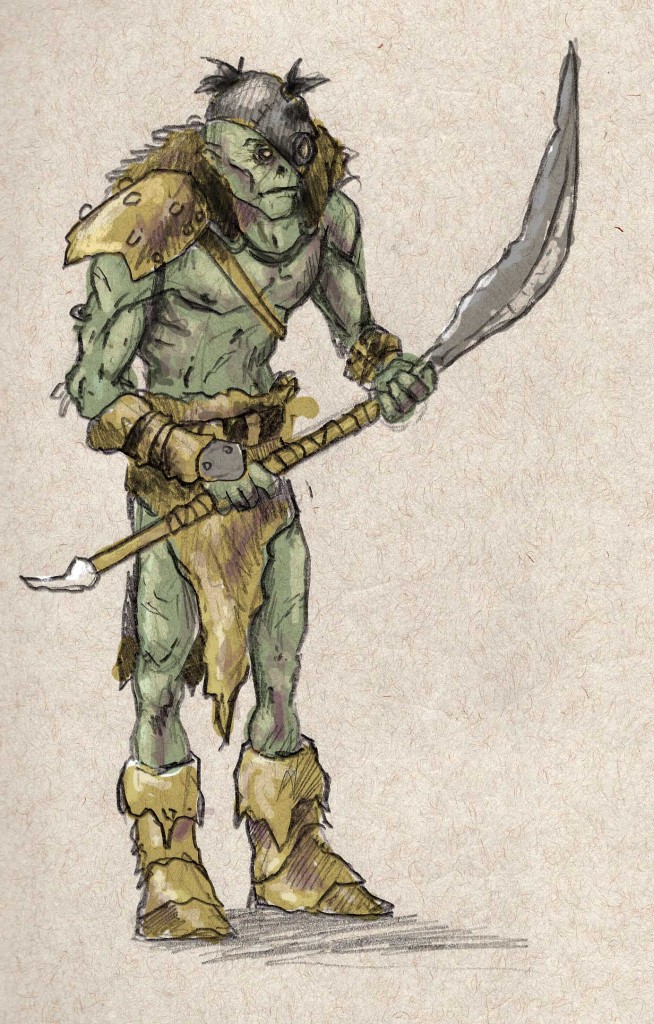Savage is the only word needed to describe the ghul. Supposedly, these creatures are the twisted remains of Eastlanders who were caught in the dark magics of the Aradan War. They are now the most widely spread menace to civilization. Raiders, bandits, cannibals—there is no limit to their depravity and madness.
—Journal of Jarin Plainswalker
The origins of the ghul cannot be stated with certainty, but they appear to be the descendants of those who were twisted and deranged by the dark magic of the 30-year war between Aradan and Pardalor. Whatever the truth, they have become a twisted, evil, and outcast people. Dworvs call them “ghuls,” which in their tongue is related to the word “lost.”
The ghul hate all other living things and show a strong dislike between their own tribes. They are hunter-gatherer societies—more like packs—who take advantage of any easy prey, from animals to farmers. They are raiders, feared in any land through which they roam. Luckily, due to their exceedingly chaotic and violent nature, their population has typically remained sparse in the 700 years since they were first encountered.
They are most common in the East, though lately some have been seen as far west as Garaden. In recent years, rumors have begun to spread that someone has organized them for some sinister purpose. With all the strife now in the North, we can only hope that this is just a rumor.
One common trait they seem to share is a reverence for honorific body scarification and disfigurement. This may be due to the deformities that many suffer from long exposure to the toxins in the Eastern plains.
Little else is known of the ghul, as their beliefs, languages, and rituals differ widely from tribe to tribe.
—Etahn
Etahn and I encountered a band of ghul on our first research excursion. We had no choice but to destroy them, as consumed by hatred for our kind and unrelenting in their aggression as they were.
But what can one expect of a people of such tragic history? Many historians believe—and the evidence is quite convincing—that the ghul are direct descendants of those who fought for the Warlock King, used by his necromancers as disposable fodder for the front line of that bloody war. They did not choose to become what they did—who would?
The ghul appear mostly teran, though they often look emaciated and pale; some can grow larger than teran and more muscular. They scar, disfigure, and tattoo themselves. It is because of their appearance that many do not believe that they are descended from terans.
—Delgon
Ghul
- Challenge Rating: 1/2
- Size: Medium
- Type: Humanoid (Unman)
- Initiative: +1
Defense
- Hit Points: 5 (1HD: 1d8 +1)
- Armor Class: 14 , touch 10, flat-footed 13 (+3 studded leather armor, +1 DEX)
- Saves: Fort +3 Ref +1 Will -1
- Weakness: –
Offense
- Speed: 30 ft.
- Base Attack: +1
- Melee: Jagged Long Sword +3 (1d8 +1)
- Ranged: Shortbow +2 (1d6)
- Special Attacks: –
- Horror Effects: First Encounter 0/1
Statistics
- Abilities: STR +2, DEX +1, CON +1, INT -2, WIS -1, CHA -1
- Skills: Acrobatics +1, Athletics +2, Awareness -1, Endurance +3, Knowledge -2, Persuasion -1, Spellcraft -1, Survival -1, Thievery +1
- Talents: Tenacity
- Special Qualities: Low-Light Vision; Natural Resistance:+2 Save vs Poison and Disease
Ecology
- Environment: Any
- Organization: Single, Pair, Tribe (2-10)
- Treasure: Standard

Ghul Shaman
Ghul tribes are often led by a single shaman. These shaman understand the visions of both worlds and lead their people, hoping to find their way in a world that rejected them.
Ghul Shaman
- Challenge Rating: 1
- Size: M
- Type: Humanoid (Unman)
- Initiative: +1
Defense
- Hit Points: 11 (2HD: 2d8+2)
- Armor Class: 14, touch 11, flat-footed 13 (+3 armor, +1 DEX )
- Saves: Fort +4 Ref +1 Will +4
- Weaknesses: –
Offense
- Speed: 30 ft.
- Base Attack: +1
- Melee: Dagger +0 (1d4-1)
- Ranged: Shortbow +2 (1d6)
- Special Attacks: Wild Magic +1 (1d4+1)
- Horror Effects: First Encounter 0/1d2
- Mana: 3
Statistics
- Abilities: STR -1, DEX +1, CON +1, INT 0, WIS +1, CHA -1
- Skills: Acrobatics +3, Athletics -1, Awareness +3, Endurance +1, Knowledge 1, Persuasion -1, Spellcraft +6, Survival +3, Thievery +3
- Talents: 1 point: Magical Aptitude
- Special Qualities: Low-Light Vision, Spell Memory, Spell Sight, Focus and Ravage
Ecology
- Environment: Any
- Organization: Solitary, Band (1 shaman, 5 ghul warriors)
- Treasure: Standard, Leather Armor
- 0 – daze, minor trick
- 1 – doom, mage bolt
- 3 – soften earth and stone
Spell Sight
A wylder can use Spell Sight to memorize a spell that they witness being cast. This ability is detailed further in the chapter on Magic.
Spell Memory
Unable to record spells in a spellbook, wylders are limited to a number of spells they can know at a given time. This is based on class, level, and ability score. A wylder can commit a number of spells to memory equal to their Spell Memory Allotment for a given spell level plus their primary ability score modifier.
Spell Memory Allotment
| Spellcaster Level | Allowed Spells in Memory |
| 1 | 6 |
| 2 | 7 |
| 3 | 8 |
| 4 | 9 |
| 5 | 12 |
| 6 | 14 |
| 7 | 17 |
| 8 | 19 |
A burst of energy explodes from the wylder’s hands towards a target. On a successful ranged touch attack with a +2 to the roll (figured in above), the wylder inflicts 1d4+1 damage as a force effect. Range 60’.
Focus and Ravage
An unman shaman can do focusing and ravaging to cast more spells as described in the Sagaborn Core Rulebook.
